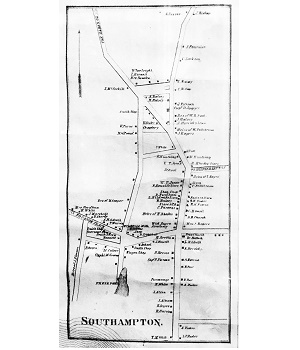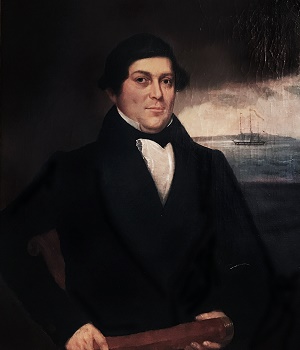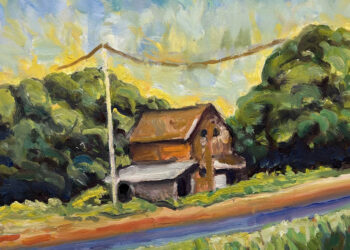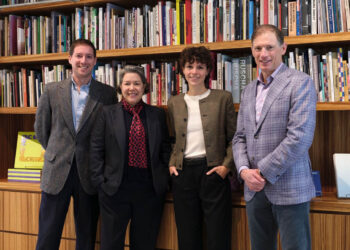Southampton Historical Museum is set to debut Hunting the Whale: The Rise and Fall of a Southampton Industry, a new interactive and inclusive exhibit that enriches the museum’s vast collection of documentation and artifacts that were accumulated throughout the past 100 years with new unseen finds. The menagerie of mesmerizing objects illuminate Southampton Village’s notable role in the whaling industry at its mid-19th century height.
 |
|
A map of the Southampton Village from 1858. |
“Hunting whales has an ancient history beginning with Paleo-Indians arriving to hunt big game 12,000 years ago,” explained Tom Edmonds, Executive Director of Southampton Historical Museums and Research Center. “Southampton had the first commercial patent for off-shore whaling in the colonies.”
Housed in Southampton Historical Museum’s historic Captain Albert Rogers Mansion, Hunting the Whale: The Rise and Fall of a Southampton Industry will encompass whaling tools, maps, illustrations, archival images and text, with a focus on local indigenous people, slaves, servants, and whaling captains, as well as the families that were sustained by the whaling industry. Captain Albert Rogers Mansion is a 20 room Greek-revival house that was constructed in 1843 – the height of the whaling industry. Captain Rogers built and lived at the Southampton mansion. He was just one of the many thriving whaling captains who decided to call Southampton home during the 19th century.
“In 1650 Captain John Ogden developed a whaling port called Feversham at Conscience Point in North Sea Harbor on the Peconic Bay. Feversham developed into the 3rd largest port in North America behind Boston and Philadelphia,” shared Edmonds. “The whaling industry was essential to the development of all the communities on the East End with one-half of the East End population was involved by supplying sailors, trade goods, ship building, tool making, etc.”
 |
|
Sperm Whale in a Flurry by Louis Ambroise Garneray, c 1840. |
Historian William S. Pelletreau noted that over 40 whaling captains remained in Southampton towards the end of the 19th century, even after the great whaling boom was no longer exceptionally prosperous.
“The industry peaked in the mid-19th century then rapidly declined because of overkill of whales and the introduction of kerosene,” Edmonds noted. “This colorful and romantic look at Southampton’s major industry will be captured in the new exhibit Hunting the Whale at the Rogers Mansion, a 1843 whaling captain’s mansion, and in a series of lectures co-sponsored by the Southampton Historical Museum and Rogers Memorial Library.”
 |
|
Captain Albert Rogers by Fredrick Spencer c. 1840. |
Hunting the Whale: The Rise and Fall of a Southampton Industry will be on display from Saturday, March 4th through Saturday, December 30th. An opening reception will take place on Saturday, March 4th from 4 to 6 p.m.
Additionally, Southampton Historical Museum and the Rogers Memorial Library will present The Men Who Hunted The Whale: Southampton’s Many Sea Captain on Thursday, March 9th. The event will begin with a lecture at the Rogers Memorial Library (91 Coopers Farm Road, Southampton) at 1 p.m., followed by a Self-Guided Tour of the Rogers Mansion at 2:30 p.m. During the talk, Edmonds will discuss the daring seamen that resided in Southampton.
On Thursday, March 23rd, Southampton Historical Museum and the Rogers Memorial Library will partner again to host Shinnecock Culture & Whaling History with David Bunn Martine. Taking place at the Rogers Mansion at 11 a.m., David Bunn Martine, the great-great-grandson of David Waukus Bunn, a Shinnecock whaler who was killed during the “Circassian” shipwreck off Bridgehampton in 1876, will lead a conversation about Shinnecock whaling and Shinnecock cultural history. Martine is a writer and artist that serves as the curator of the Shinnecock Museum and tribal Historic Preservation Officer.
Admission to the Hunting the Whale: The Rise and Fall of a Southampton Industry opening and lecture series is free.
Southampton Historical Museum’s Rogers Mansion is located at 17 Meeting House Lane in Southampton. For more information, call 631-283-2494 or visit www.southamptonhistoricalmuseum.org.












